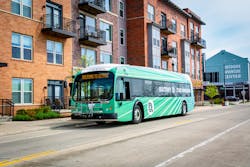Detroit DOT starts EV Transition with Four Buses in Fleet
The Detroit Department of Transportation (DDOT) has started using four Proterra electric buses – the first four to be added to its fleet.
The new buses will ply along routes based out of the Shoemaker Terminal, where the charging station is installed.
The Proterra buses produce less emissions, are more energy efficient, have fewer parts and are quieter than fossil fuel buses. The buses use rechargeable batteries and do not have any harmful emissions. The motors have fewer moving parts and are less costly to maintain. The electric buses can run about 200 to 250 miles on a single charge.
Ken Becker, Regional Sales Director for bus manufacturer Proterra, said, “Transitioning to clean transportation is not just the right thing to do for our health and environment, it’s also the smart thing to do for our communities.”
“Each time a Proterra battery-electric bus replaces a diesel bus, 230,000 pounds of carbon pollution are avoided each year,” he added.
Moreover, these buses do not depend on fuels with fluctuating costs, this helps operators save on operating costs.
The DDOT will test the buses in the coming months and ensure that the electric buses perform as well as the diesel ones, particularly during the harsh winters.
About the Author
EnergyTech Staff
Rod Walton is senior editor for EnergyTech.com. He has spent 17 years covering the energy industry as a newspaper and trade journalist.
Walton formerly was energy writer and business editor at the Tulsa World. Later, he spent six years covering the electricity power sector for Pennwell and Clarion Events. He joined Endeavor and EnergyTech in November 2021.
He can be reached at [email protected].
EnergyTech is focused on the mission critical and large-scale energy users and their sustainability and resiliency goals. These include the commercial and industrial sectors, as well as the military, universities, data centers and microgrids.
Many large-scale energy users such as Fortune 500 companies, and mission-critical users such as military bases, universities, healthcare facilities, public safety and data centers, shifting their energy priorities to reach net-zero carbon goals within the coming decades. These include plans for renewable energy power purchase agreements, but also on-site resiliency projects such as microgrids, combined heat and power, rooftop solar, energy storage, digitalization and building efficiency upgrades.
